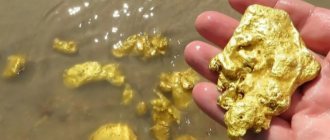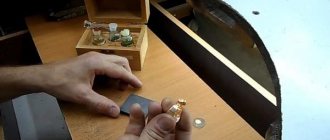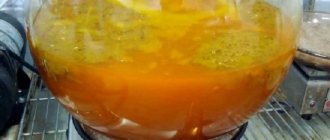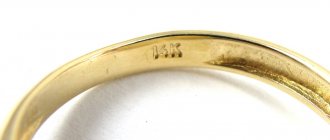Post updated: May 25, 2020
Gold leaf is the thinnest sheets of precious metal up to a fraction of a micron thick. This unusual material is used for gilding jewelry and other products, the production of which involves coating with tinsel. The sheets are made either of pure yellow metal or of its alloys with silver or copper. The physical properties of gold allow the minimum thickness of leaf plates to be achieved - pure metal is soft and malleable. The simplest example of objects covered with tinsel is the domes of churches, which for several centuries have traditionally been finished with sheets of the thinnest sheets of precious metal. How do modern craftsmen do gilding with gold leaf?
Production of tinsel
The softness and malleability of pure gold allows the metal to be rolled into very thin sheets. Thanks to these physical properties of the metal, the sheets are obtained without cracks and breaks, that is, they are not damaged during the manufacturing process. The process of producing gold sheets begins with the casting of a bar. An ingot with dimensions of 20x5x1 cm is cast from metal, and then carefully rolled into a strip. The length of such a strip can reach 30 meters.
How to continue working with gold leaf? The strip is cut into squares, which are folded together, separated by paper sheets. Before the tinsel can be used for gilding work, this book is sent under a hammer that works about two thousand blows. Under the blows of the instrument, the sheets of tinsel become even thinner and form a kind of “cake”. A square is cut out of the “cake” and placed in a book.
The most important stage in the production of tinsel is beating the gold with a hammer. This procedure is very labor-intensive and difficult to perform. The hammer must strike so that the blows occur not only in a certain sequence, but also with the same force. Compliance with these requirements is mandatory, as it ensures the same thickness of the gold sheets over their entire area.
One book contains up to three hundred leaf sheets, each of which becomes 10 times larger after the beating procedure. For the most complete picture of the tinsel production process, it is recommended to watch the video, which reflects each stage of the production of thin gold sheets. Working with gold leaf largely depends on the quality of the sheets. If the sheets are made in accordance with all the rules, then the gilding of the product will also meet all quality requirements.
Gilding with paint
There are ready-made gold paints, which, when applied to a cleaned surface, give the product a golden appearance. The paint consists of a metal powder that reproduces the color of the metal (gold, bronze, copper, iron, etc.). However, paint can only approximately imitate real leaf coating.
1. Acrylic paint is applied to the prepared wooden candlestick as a primer. Red goes better with gold and cool blue with silver. Let the soil dry. | 2. Before application, the gold paint is thoroughly mixed with a wooden stick, as the pigments settle to the bottom of the container. A small amount of gold paint is poured into an old saucer and the candlestick is evenly tinted from bottom to top. The paint dries very quickly. | 3. To give the candlestick an antique look, after the paint has dried, the “golden” layer is lightly sanded with coarse wool until the red primer layer begins to show through in some places. |
Gilding tinsel
The technology of gilding with tinsel is based on one unusual property of gold: metal, rolled to a very small thickness, adheres to smooth surfaces at the molecular level. Coating a product with tinsel is a complex process, since working with the thinnest sheets of precious metal requires attention and accuracy. Casting a product from gold is much easier than covering the same product with tinsel.
This unusual property allows gold leaf to be used to decorate church domes, statues, fountain compositions, as well as pieces of furniture used to create a luxurious environment. The technology of applying material has changed throughout human history. Now tinsel is used as packaging for expensive sweets and even as an ingredient in coffee and cocktail drinks.
Among the methods of gilding with tinsel, experts distinguish two options: attaching the precious metal to polyment and to mordan. What is their difference? Polyment is a kind of base on which sheets of tinsel are attached. The composition of the polyment is based on clay, to which soap, white beeswax and whale oil are added in small quantities. The peculiarity of this method of gilding can be considered the final result: the surface takes on the appearance of real gold and looks as if it were made of metal. Attaching tinsel to polyment requires large financial and labor costs, so it is used in cases where it is necessary to treat a surface that is not exposed to the external environment. Most often, furniture is gilded this way.
What is a leaf coating on a mordan? This treatment of the product with gold allows you to give its surface a matte effect. To carry out the procedure, materials based on vegetable oils are used; Mordan varnish itself is prepared from flax and hemp oil with the addition of special components. In this case, treating the surface with tinsel is easier and faster. Mounting on the face allows you to decorate a variety of surfaces, including wood, plaster, and marble.
Before gilding the face, the surface of the product is primed with cinnabar and then wiped with cloth to remove irregularities. The prepared part is covered with mordan and dried for the required time. Depending on the variety of Mordan, drying can last from several hours to a whole day. Before applying the tinsel, the master checks the surface for “tack-free” conditions. It is very important here not to dry the mordan completely, since gold will not stick well to a dry surface. Undried mordan is also not suitable for gilding with gold leaf, since the sheets of material will sink in it. Considering the value of gold, all work should be carried out strictly according to technology and very carefully.
What is gold leaf
Gold leaf is thin sheets glued to the surface of items to create the impression that the entire item is made of yellow metal. The thickness of such sheets can reach several tens of nanometers.
It was first produced in China several thousand years ago. Production was quite simple, because gold is a soft and malleable metal, from which you can get the thinnest sheets without gaps or cracks.
Russia adopted this unique technology, calling the products tinsel or gold leaf. The name comes from the ancient Russian word “susal”, which literally meant “face”, from here it is easy to understand the origin of the term, because only the front side of the product is covered with gold.
The classic standard of gold leaf is 960. This is how the color of gold turns out warm, yellow or the so-called “fiery yellow”. This is the coloring of native metal. Only such a sample is fixed by GOST and can be called gold leaf.
Based on the high cost of such finishing, you can often find imitation tinsel or various gold alloys. Types and differences of gold leaf:
- Double - with this alloy, gold is layered on silver.
- Talma - with this alloy, gold is layered on copper.
- Potal is an imitation of tinsel without the presence of noble metals, made using metal plates (copper and aluminum) or various alloys (copper and zinc). With this method, to protect against corrosion, it is necessary to coat the product with varnish.
- Tin sulfide or Mousse gold is an imitation of gilding using metallized paint to which a compound of sulfur and tin is added.
- Titanium nitride is a very durable and wear-resistant coating that allows you to vary the shades of gold using nitrogen.
- Gold foil, one of the most recent developments, is a copper alloy coated with nickel and cobalt.
Simplified technology
The process of applying gold leaf to a surface can be represented as the following algorithm. Three layers of acrylic primer are applied to the product, and the first layer should be more liquid than all the others. This is necessary in order to saturate the surface. The first and second layers are dried for an hour, after applying the third layer the product is left to dry for about 8 hours.
The dried surface is sanded using abrasive paper, P240 or P400 paper is suitable. Then we apply shellac varnish to the product with a brush, dry it and sand it again, but with P600 marking paper. After all the preparatory procedures, the part is treated with Mordan and dried to the required level of stickiness.
After the mordan has dried to the required level of stickiness, gold leaf can be applied. The material is applied and pressed with a brush to avoid shifting. After a day, the product can be additionally polished with cotton, which will not damage the gold-plated surface. If you have all the components, this procedure for applying gold plating can be carried out at home.
Decorative gilding
Precious metals have always been used in the finishing and decoration of palace interiors, creating the impression of unimaginable wealth and luxury. But it is possible to make a small object sparkle without large financial costs.
Gilding is a creative process. Two wooden candlesticks show us how the transformation takes place. It’s easy to transform your original walls. The basis will be a smooth surface, for example, vinyl wallpaper. Apply the paint to the wall using a template, lightly touching it with a brush dipped in gold paint. Gold and silver colors will easily give a noble look to the most ordinary things: candlesticks, paintings, boxes.
Modern technologies
The technology of gilding with gold leaf has undergone some changes throughout the history of using this material for surface finishing. The essence of the technology for producing tinsel sheets remains the same: a bar of precious metal is rolled into strips, cut into squares, the squares are put into a book and sent under the hammer. New developments make it possible to achieve sheets that are much thinner than those that were produced before. The task of the craftsmen is simplified by the use of computer technology.
Now gold leaf is practically not produced by hand; outdated technologies are a thing of the past. The process of obtaining thin leaf sheets today is completely automated, everything is done by machine. The electric hammer is configured for both the initial beating of sheets and the subsequent processing of precious metal to a minimum thickness. The casings of bovine intestines, which used to be used to wrap tinsel sheets, are also no longer used. Instead, modern plastic forms are used.
In Russia, the production of tinsel is carried out by a non-ferrous alloys plant located in Moscow. There are also private companies producing gold leaf, but their production volumes of material for mechanical gilding are not significant.
To understand what tinsel looks like, just imagine a very thin sheet of foil up to 1.5 microns thick. According to domestic standards, tinsel is produced in square sheets with a side of 91.5 mm. The sheets are laid out in books, the separator between the sheets is tissue paper. Books can consist of 10 or 60 leaf sheets.
In order to imagine how gold leaf should be applied, it is recommended to watch a video accompanied by explanations from the master. Experts distinguish two types of gold leaf: free and transfer. Depending on the type of tinsel, there are differences in working with the material. Free gold is taken out of the book and placed on the pillow, and transfer gold is initially glued to a sheet in the book.
Preparation for decorative gilding
Gilding is a very complex and lengthy process that requires patience, accuracy and experience. To gain this experience, you should start with simpler methods of decoration that imitate gold plating. Our goal is to give our products a beautiful, noble, sparkling look. And naturally, the gold surface should have an impeccable appearance. The slightest imperfections: traces of processing, scratches, roughness, even specks of dust - and the work is ruined! Therefore, the surface of a wooden object is sanded, cracks are sealed, and dust is carefully removed.
Using liquid gold paint, you can apply a geometric or floral design to the wall. Contrasting transitions between the red matte color of the wall and the gold pattern, sparkling metal, create the effect of truly royal wealth.
Spray paint gilding
Aerosol paints that imitate metal are now widely available. They can be applied to any surface: paper, wood, metal, plastic, glass, even to the wall. You can buy aerosol “gold” at car dealerships. With its help, you can not only create golden wheel caps for your car, but also elevate nondescript interior items. A table lamp, old picture frames, cornices blackened by time - there are a lot of places to use them! To obtain a brilliant result, it is important that the surface is dry and thoroughly cleaned of dust and rust. The treatment must be carried out twice. Both layers will dry within an hour. Unfortunately, it is technically impossible to maintain shine for a long time. But don’t be upset: when the shine fades, just apply a new layer of gold-plated aerosol.
On the eve of the New Year's carnival, we'll give one more idea to parents: your daughter will probably love that her quite ordinary shoes have suddenly turned into golden ballroom slippers. Just don’t forget to degrease them before painting!
How to make mixtion with your own hands: two recipes
Craftsmen have been using their own secrets for many centuries to prepare Mordan glue. Previously, this art was practiced by icon painters; they found a way out in simple improvised means, creating masterpieces that are still revered by connoisseurs to this day.
And today you can make simple potali glue with your own hands from what you have in the kitchen. Experienced craftsmen use egg whites, garlic juice, sugar syrup, starch and other astringents. We suggest you take note of the two most durable and easiest to prepare compositions, recognized by the majority of decorators.
DIY starch glue
So, you will need a glass of water, 70 g of granulated sugar, 1/3 cup of food starch and a tablespoon of white vinegar. To prepare, follow these steps step by step:
- heat 200 ml of water until warm, dissolve sugar in it and bring the syrup to a boil;
- pour vinegar into the mixture and mix the mixture thoroughly.
- the liquid should be kept on the fire for no more than half a minute;
- add starch to the syrup, constantly stirring the emulsion;
- When the resulting mixtion has cooled, its consistency should resemble sour cream.











